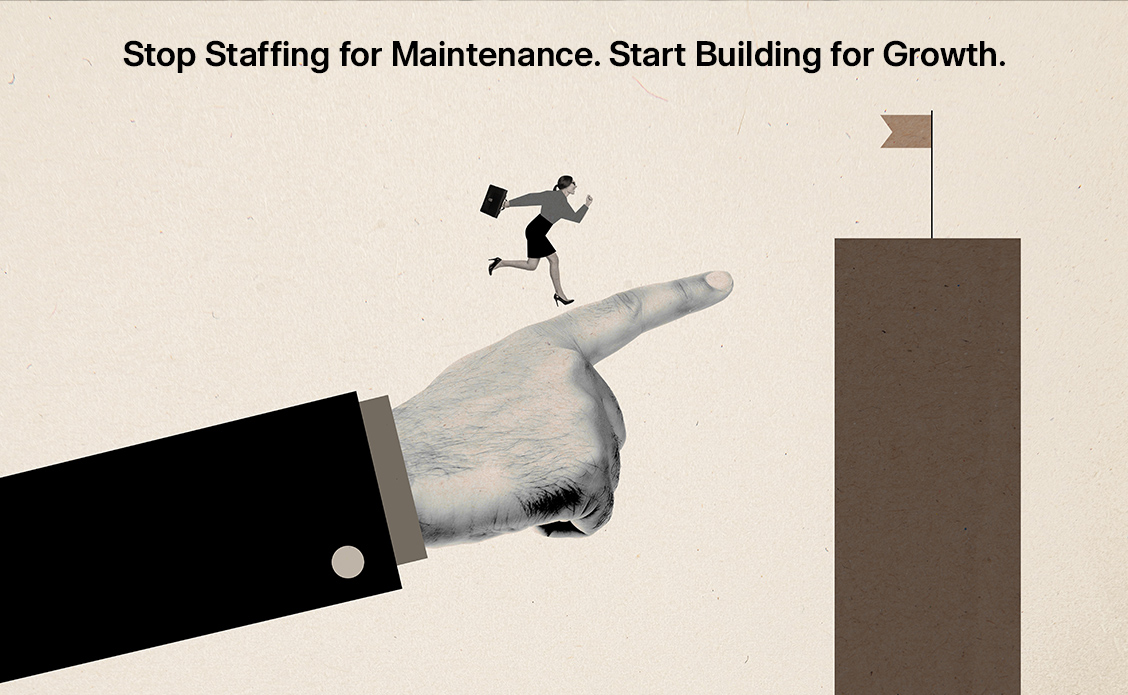Let’s address the founder’s dilemma:
You need to scale—fast. But hiring ahead of growth is risky. Overstaffing kills your burn. Understaffing stalls momentum. And somewhere between the headcount model and the hiring freeze lies a smarter play:
The on-demand model.
At NextAccel, we advise venture-backed companies on how to scale operations, GTM, and finance without dragging organizational complexity behind them. The fastest-growing teams we work with don’t scale everything. They scale selectively—leveraging fractional, embedded, and outsourced talent to extend their capabilities without bloating their core team.
This article unpacks how to build a high-leverage business with a lean team—and how to use the on-demand model as a strategic operating layer, not just a cost-saving tactic.
The Headcount Myth: Growth ≠ Hiring
Founders are often conditioned to see hiring as a proxy for progress.
- “We’re hiring 50 this year.”
- “We just built out our full sales org.”
- “We now have a team for every function.”
But more headcount ≠ more velocity. In fact, past a point, it often delivers the opposite:
- Slower decision-making
- More internal drag (meetings, alignment, overhead)
- Higher burn and shorter runway
- Lower output per employee
- Culture dilution
Scaling intelligently means asking: What’s critical to own vs. what’s better run as a service?
The On-Demand Model Defined
The on-demand model replaces fixed headcount with flexible, outcome-driven capacity.
It includes:
- Fractional leaders (e.g., CFO, RevOps, GTM strategist)
- Embedded teams (e.g., sales development, ops, finance execution)
- Specialist agencies or consultants (e.g., paid media, talent sourcing, legal, FP&A)
But here’s the mindset shift: You’re not outsourcing tasks.
You’re renting strategic leverage.
Where On-Demand Unlocks Real Value
We see the on-demand model drive exponential ROI in 5 core functions:
1. Finance + FP&A
Hiring a CFO too early costs you $200K+ and often underutilizes the role. Instead:
- Use a fractional CFO to own fundraising, board reporting, and cash strategy
- Layer in embedded finance ops to run invoicing, forecasting, and reconciliation
- Add FP&A partners to build models without in-house teams
Outcome: Investor-grade finance, zero fixed headcount.
2. Revenue Operations
RevOps is critical—but hard to build early. Most early teams need better systems, not more people.
- A fractional RevOps lead can unify your CRM, pipeline, and attribution models
- Embedded RevOps support can build playbooks, dashboards, and automations
- No need to hire full-time until >$10M ARR or complex GTM layering kicks in
Outcome: Clean data, fast insights, scalable GTM—on tap.
3. Sales Development
Hiring, ramping, and retaining SDRs is time-consuming and risky. Many early teams spend more managing SDRs than closing deals.
- Partner with embedded outbound firms that specialize in ICP discovery and pipeline creation
- Align comp to meetings booked, not hours worked
- Maintain control of messaging and brand while scaling pipeline
Outcome: Pipeline without payroll bloat.
4. Customer Implementation & Success
Need coverage but not full-time headcount? Outsourced onboarding or implementation teams can:
- Reduce lag from deal close to go-live
- Ensure consistency in experience
- Free up your CS team to focus on expansion and renewals
Outcome: Better retention. Lower CAC payback. No CS burnout.
5. Specialized Execution
Need to run a campaign, build a pricing model, rework comp plans, or launch in a new region?
- Pull in domain experts on 30- to 90-day sprints
- Skip the search + ramp cycle
- Get top-1% execution—without long-term commitment
Outcome: Focused firepower, right when you need it.
When to Use On-Demand vs. Hiring In-House
Here’s a simple framework we share with clients:
| Question | Hire Full-Time | Use On-Demand |
|---|---|---|
| Is it a core differentiator? | ✅ | |
| Will we need this role daily for 12+ months? | ✅ | |
| Do we have the systems to support them? | ✅ | |
| Is this a fast-moving or undefined area? | ✅ | |
| Are we trying to learn/test first? | ✅ | |
| Do we need outcomes fast? | ✅ |
In other words: build the core, rent the edge.
How Founders Can Operationalize the On-Demand Model
Hiring on-demand doesn’t mean delegating blindly. It means managing strategically.
Here’s how to do it right:
1. Define the outcome, not just the deliverable
Don’t ask for “support with CRM.” Ask for “automated lead routing across ICPs with dashboard visibility by region.”
2. Align on scope, timeline, and handoffs
Clarity upfront reduces churn mid-engagement. Define what “done” looks like.
3. Build documentation into the scope
Any good on-demand partner should leave behind SOPs, workflows, and system maps. Treat it as an asset transfer.
4. Use the same operating cadence
Bring fractional partners into standups, weekly check-ins, or board prep cycles. Integration = impact.
5. Reassess quarterly
Some functions may shift from on-demand to in-house as you scale. That’s a feature, not a flaw.
Real-World Example: $7M SaaS Company That Scaled Without Bloat
We worked with a $7M ARR company that needed to:
- Launch outbound
- Clean up Salesforce
- Raise a bridge round
- Improve cash forecasting
- Fix churn in onboarding
They had no RevOps, no CFO, and 1 overwhelmed CS lead.
Rather than hire 4 roles, they:
- Engaged a fractional CFO for investor readiness
- Used embedded RevOps for a 6-week systems reset
- Pulled in an outbound SDR pod for a 90-day launch
- Added an implementation-as-a-service partner for onboarding
Result:
Revenue per employee jumped 22%
Pipeline doubled in 60 days
Burn held steady—despite 2x activity
This is the on-demand model in action.
Final Thought: Scale Smart. Not Heavy.
“Velocity isn’t just about speed—it’s about efficiency.”
Founders who embrace the on-demand model scale faster, with fewer mistakes, and greater control. They reduce hiring risk. They extend runway. And they focus headcount on what they must own to win.
At NextAccel, we help growth-stage teams design operating models that expand capacity without expanding burn.
Want to audit your headcount strategy?
Contact us for a 90-minute Lean Org Diagnostic.




